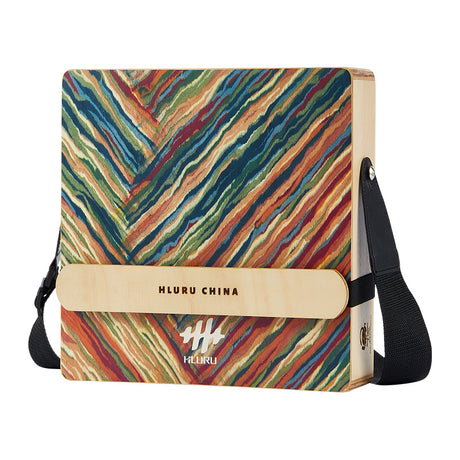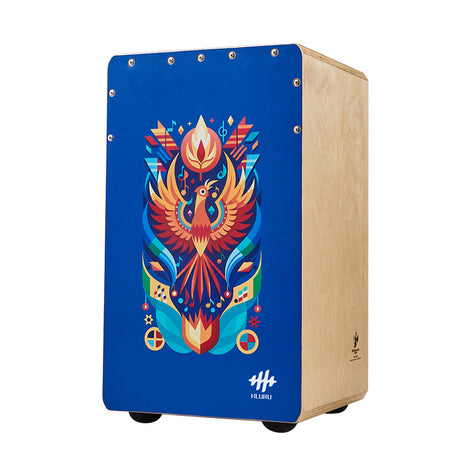Cajón de arce HLURU, tambor de percusión 3 en 1 para sanación sonora - 30CN, color tortuga negra
$67.00$78.00Precio unitario /AgotadoCajón de fresno chino HLURU, ajustable, para musicoterapia - Pájaro Bermellón 48CN
$215.99$227.00Precio unitario /AgotadoCajón Hluru multifuncional y desmontable Ziricote para musicoterapia - Tortuga negra
$299.99$399.99Precio unitario /AgotadoCajón de arce pintado HLURU, 3 en 1, para sanación sonora - 30CN, color tortuga negra
$68.99$79.99Precio unitario /AgotadoCajón chino de fresno Hluru 48CN azul índigo para musicoterapia - Pájaro Bermellón
$213.99$313.99Precio unitario /AgotadoCajón chino de fresno Hluru 48CN teñido con tinta para meditación - Pájaro Bermellón
$213.99$313.99Precio unitario /AgotadoCajón de fresno chino Hluru 48CN Escarcha para la atención plena - Pájaro Bermellón
$213.99$313.99Precio unitario /Agotado- $209.99
$309.99Precio unitario /Agotado - $209.99
$309.99Precio unitario /Agotado Cajón HLURU, tambor de percusión para relajación - White Tiger
Desde $215.99$255.00Precio unitario /Agotado- $129.00
$169.00Precio unitario /Agotado
Lista de reproducción de música de cajón
El cajón te hace sentir el ritmo de los latidos de tu corazón.
🌍✨La emocionante interpretación de LinXiao en el cajón Hluru te invita a aprovechar tus instintos primarios y abrazar la vibrante energía del ritmo. Cada golpe impactante resuena profundamente, llenando el aire con un sonido dinámico que hace eco del latido del corazón de la vida misma. A medida que los ricos tonos Cuando el cajón cobra vida bajo las hábiles manos de LinXiao, los oyentes son transportados a un mundo donde la música se convierte en una poderosa fuerza de expresión.
Acerca del Cajón Box Drum, Todo lo que necesitas saber.
¿Qué es el cajón? El origen del cajón.
¿Qué es el cajón? El origen del cajón.
El cajón (pronunciado Cahone) es un pequeño tambor de madera de tipo caja originario de Perú. A lo largo del tiempo, el cajón se ha utilizado para diferentes estilos musicales. Ahora se ve a menudo en la música flamenca y es cada vez más popular en el folk acústico, el rock y el pop. Es principalmente un instrumento de percusión manual, se puede tocar con escobillas o mazos.
Detrás de este instrumento de madera aparentemente sencillo se esconde una historia bastante enrevesada. Sus orígenes se remontan al siglo XVIII en África. Antes de ser vendidos como esclavos en América, los africanos tenían una rica tradición de percusión. Utilizaban una variedad de instrumentos para tocar música, expresar emociones y transmitir mensajes. Cuando los africanos fueron esclavizados y transportados a América, se les privó de casi todo, incluidos sus instrumentos. Para aliviar su nostalgia, comenzaron a utilizar cajas de madera y otros objetos en los barcos para imitar los sonidos de los tambores africanos. En las duras condiciones de trabajo, el cajón se convirtió en un consuelo espiritual para los africanos esclavizados, proporcionándoles consuelo. Con el tiempo, el cajón surgió de la música folclórica y gradualmente ganó popularidad entre los músicos de todo el mundo.
- Tipos de cajón
Existen tres tipos principales de cajón. Todos los cajones suelen estar hechos de madera contrachapada con una superficie de juego de madera contrachapada fina sostenida por lados más gruesos. Los cajones también tienen un orificio de sonido ubicado en la parte posterior o en el costado. - Cajón delanteroCajón trasero
La versión original es una versión estándar sin la adición de efectos de tipo caja. - Cajón de caja
Mi cajón es de tipo caja. Dentro del tambor hay una hilera de resortes de caja. Estos presionan contra la parte delantera del tambor para darle un ligero sonido de caja cuando se toca. Hay algunas otras variaciones que se utilizan para agregar un efecto de caja. Los cajones flamencos usan cuerdas de guitarra de nailon y otros usan campanas o sonajeros.
Agujero de cajón - Cajón híbrido
También existen algunas variaciones de diseño. Existe un cajón de regazo, que es una versión más pequeña para computadora portátil. También he visto versiones con una superficie frontal inclinada e incluso cajones congas. También se han experimentado con diferentes materiales. Meinl ofrece una superficie de juego de fibra de vidrio y hay una imagen en la web de una versión completamente acrílica.
¿Es difícil tocar el cajón?
¿Es difícil tocar el cajón?
El cajón no es, en realidad, muy difícil de tocar, lo que lo convierte en un instrumento ideal para principiantes. Básicamente, se trata de una caja de madera sin componentes complejos, lo que hace que sea muy fácil empezar a tocarlo. Al golpear diferentes partes de la superficie con distintos grados de fuerza, se puede producir una amplia gama de tonos que se adaptan a diferentes estilos musicales. El estilo de tocar el cajón es bastante flexible, lo que permite la improvisación en función de la música. En comparación con otros instrumentos de percusión, es más fácil de aprender y ofrece un sonido rico, lo que lo convierte en un instrumento divertido de tocar.
Técnicas básicas para tocar el cajón
- Golpe de bajo: golpee el centro de la superficie de juego con el talón de la mano para producir un sonido profundo y resonante que imite un bombo.
- Golpe de palmada: golpea el borde de la superficie de juego con el talón de la mano y rebota rápidamente, produciendo un sonido brillante y agudo similar al de un tambor.
- Raspar: Deslice los dedos o la palma de la mano sobre la superficie de juego para crear un sonido de rascado.
- Frotar: Frote la palma de la mano sobre la superficie de juego para producir un zumbido continuo.
Consejos para jugar
- Control de tono: ajusta la fuerza, la posición y el ángulo de tus golpes para lograr diferentes tonos.
- Práctica de ritmo: comience con ritmos simples y aumente gradualmente la dificultad. Use un metrónomo o toque con música para practicar.
- Coordinación corporal: tocar el cajón requiere coordinación entre manos y pies. Presta atención a relajarte y coordinar tu cuerpo mientras practicas.
- Improvisación: Intenta añadir elementos improvisados a tu interpretación para que tu actuación sea más animada e interesante.
¿Cómo hacer un cajón?
¿Cómo hacer un cajón?
Parte 1: Primeros pasos
1. Reúne la madera contrachapada. Los cajones suelen estar hechos de madera contrachapada de dos grosores diferentes. La madera contrachapada más fina se utiliza para la superficie de juego delantera, mientras que la más gruesa se utiliza para el resto de la caja.
- Utilice madera contrachapada de aproximadamente 1/8 de pulgada de espesor para la placa frontal. Esta es la parte en la que tocará y, para la mayoría de los cajones, necesitará una pieza de aproximadamente 13" x 19".
- Para el resto de la caja, utilice madera contrachapada de 3/8 de pulgada de espesor.
2. Corte las piezas de madera contrachapada. Para crear el marco básico de su cajón, corte la madera contrachapada a la medida adecuada. Al cortar, sujete la madera contrachapada con una regla de metal para garantizar un corte recto y luego utilice una sierra circular o una sierra de calar.
- La parte superior e inferior deben medir 13" x 13".
- La pieza trasera única debe medir 13" x 18".
- Las dos piezas laterales deben medir 12" x 18".
3. Corte el orificio de sonido en la parte posterior. Marque el centro de la parte posterior y dibuje un círculo de 4,7 pulgadas de diámetro. Taladre un orificio en el borde del círculo y luego use una sierra de calar para cortar el círculo.
- Lije los bordes para que queden lisos.
4. Haz las cajas. El sonido único de un cajón es el efecto de caja que se produce al golpear la placa frontal. Esto se debe a las cajas, que pueden estar hechas de diversos materiales, como cuerdas de guitarra viejas, hilo de pescar o incluso clips.
- Para crear tus cajas, corta trozos del material que hayas elegido y fíjalos al interior del cajón. Puedes experimentar con distintos materiales y tensiones para lograr el sonido deseado.
Parte 2: Ensamblando la caja
1. Pegue el marco principal. Comience por la parte inferior y un lado y aplique abundante cola para madera. Luego, pegue el otro lado y la parte superior, creando la caja básica.
- Sujeta las piezas con abrazaderas, asegurándote de que las esquinas estén en ángulo recto. También puedes usar bloques de madera para crear guías y asegurar ángulos rectos.
2. Aplique presión. Las abrazaderas grandes para carpintería son ideales, pero también puede utilizar correas de trinquete. Aplique presión mientras se seca el pegamento. Deje que el pegamento se endurezca durante varias horas.
- Limpia el exceso de pegamento con un paño húmedo. Consulta las instrucciones del pegamento para madera para conocer los tiempos de secado específicos y las recomendaciones de presión.
3. Instala las cajas. Antes de pegar la placa frontal, instala las cajas. Hay muchas formas de colocar las cajas, pero lo ideal es que puedas afinarlas.
- Estire las cajas desde la esquina superior hasta la esquina opuesta, aproximadamente a 3 pulgadas del borde. Sujételas con tornillos para madera o fíjelas a clavijas de afinación.
4. Pega las placas delantera y trasera. Coloca las placas delantera y trasera y aplica pegamento. Sujétalas en su lugar, asegurándote de que la boca de sonido esté en la parte inferior y las cajas en la parte superior. Es posible que quieras agregar tornillos para madera para mayor estabilidad, especialmente porque estarás sentado sobre el cajón.
Parte 3: Toques finales
- Añade una base. Corta un trozo de madera contrachapada o goma que se ajuste a la base del cajón. Esto proporcionará una amortiguación para tus pies y evitará que el cajón se deslice.
- Redondea las esquinas. Lija las esquinas de la parte superior para que sea más cómodo sentarse. Usa papel de lija cada vez más fino hasta lograr un acabado suave.
- Personaliza tu cajón. Decora tu cajón con pintura, tinte u otros materiales para hacerlo único.
Seguridad ante todo:
- Utilice protección para los ojos y los oídos cuando utilice herramientas eléctricas.
¿Qué es la estructura de mortaja y espiga?
¿Qué es la estructura de mortaja y espiga?
La mortaja y espiga (榫卯 sǔn mǎo), la esencia de la carpintería tradicional china, es un método para conectar dos o más componentes de madera sin el uso de clavos o pegamento. Se basa únicamente en el entrelazado de estructuras salientes y hundidas dentro de la propia madera. La parte saliente se llama "espiga" (榫头), y la parte hundida se llama "mortaja" (卯眼 o 榫眼). Al insertar la espiga en la mortaja, se pueden unir firmemente dos piezas de madera.
La estructura de mortaja y espiga forma una conexión fuerte a través del ajuste apretado entre las piezas de madera, creando una unión robusta que es más segura que el uso de clavos o pegamento solo, y es menos propensa a aflojarse o romperse. Dispersa eficazmente la tensión, reduce la deformación y el agrietamiento de la madera, lo que prolonga la vida útil de los productos de madera. Además, este método de conexión elimina la necesidad de adhesivos químicos, evitando la liberación de sustancias nocivas como el formaldehído, lo que lo hace más ecológico y saludable.





























